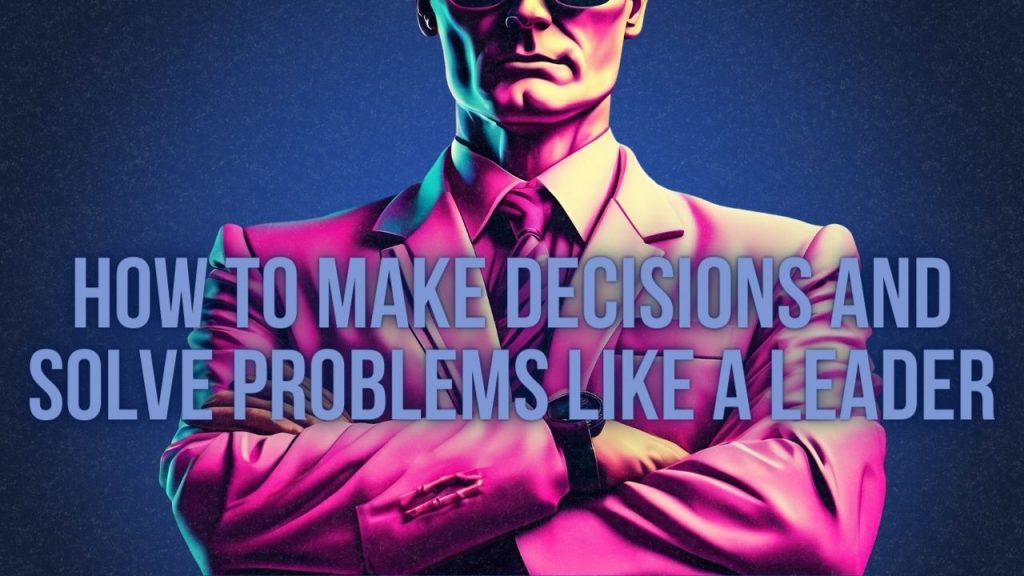Home » Uncategorized » How to make decisions and solve problems like a leader
How to make decisions and solve problems like a leader

Learn continually – there’s always “one more thing” to learn! – Steve Jobs
Effective decision-making and problem-solving are fundamental skills for leaders, influencing the success of their teams and organisations. Leaders who excel in these areas can navigate complex situations, drive innovation, and inspire their teams. Here’s an in-depth guide on how leaders can enhance these skills on a daily basis, supported by context, examples, anecdotes, habits, hacks, and strategies..
Understanding Decision-Making and Problem-Solving
Decision-making involves choosing between alternatives to reach a goal, while problem-solving entails identifying issues and finding effective solutions. Both require analytical thinking, creativity, and sound judgement.
“The quality of a leader is reflected in the standards they set for themselves.”
– Ray Kroc
“We can not solve our problems with the same level of thinking that created them.”
– Albert Einstein
Importance in Leadership
- Strategic Direction: Leaders set the course for their teams and organisations, making strategic decisions that shape the future.
- Operational Efficiency: Effective problem-solving ensures smooth operations and addresses challenges promptly.
- Team Morale: When leaders make sound decisions and solve problems efficiently, it boosts team confidence and morale.
- Innovation: Problem-solving fosters innovation by encouraging creative solutions to complex issues.
Daily Strategies for Better Decision-Making and Problem-Solving
- Adopt a Growth Mindset:
- Context: Embracing challenges as opportunities to learn can enhance decision-making skills.
- Tip: Encourage continuous learning and adaptability.
- Example: Satya Nadella, CEO of Microsoft, transformed the company culture by promoting a growth mindset, leading to greater innovation and agility.
- Gather Relevant Information:
- Tip: Make informed decisions by collecting all necessary data.
- Example: Before launching a new product, conduct thorough market research to understand customer needs and preferences.
- Use Analytical Tools:
- Context: Tools like SWOT analysis, decision matrices, and cost-benefit analysis can aid in evaluating options.
- Tip: Incorporate these tools into your decision-making process.
- Anecdote: Elon Musk often uses first principles thinking, breaking down problems to their fundamental truths and building solutions from there.
- Consider Multiple Perspectives:
- Tip: Involve diverse team members to get different viewpoints.
- Example: Jeff Bezos, founder of Amazon, encourages “disagree and commit” to ensure all voices are heard before making a final decision.
- Set Clear Objectives:
- Tip: Define what success looks like to guide your decisions.
- Example: Before initiating a project, set SMART (Specific, Measurable, Achievable, Relevant, Time-bound) goals.
- Practice Decisiveness:
- Tip: Make timely decisions to keep momentum.
- Quote: “Indecision is the thief of opportunity.” – Jim Rohn
- Reflect and Learn:
- Tip: After making a decision, reflect on the outcome and learn from the experience.
- Example: Conduct post-mortem meetings to analyse what went well and what could be improved.
Enhancing Problem-Solving Skills
- Define the Problem Clearly:
- Tip: Understand the problem thoroughly before seeking solutions.
- Example: Use the “5 Whys” technique to get to the root cause of a problem.
- Brainstorm Solutions:
- Tip: Encourage creative thinking by brainstorming multiple solutions.
- Anecdote: During the development of Pixar’s “Toy Story,” the team faced numerous challenges but used extensive brainstorming sessions to overcome them and create a groundbreaking film.
- Evaluate and Prioritise:
- Tip: Assess potential solutions and prioritise them based on feasibility and impact.
- Example: Use a decision matrix to compare different solutions against key criteria.
- Implement and Monitor:
- Tip: Execute the chosen solution and monitor its effectiveness.
- Anecdote: When Starbucks faced declining sales, Howard Schultz returned as CEO and implemented strategic changes, closely monitoring their impact, which eventually revitalised the company.
- Stay Flexible:
- Tip: Be prepared to adjust your approach as new information arises.
- Example: During the COVID-19 pandemic, many leaders had to pivot their strategies rapidly to adapt to the changing environment.
Habits and Hacks for Daily Improvement
- Set Aside Thinking Time:
- Tip: Dedicate time each day for deep thinking and problem-solving.
- Example: Bill Gates is known for his “Think Weeks,” where he takes time away to reflect and generate new ideas.
- Stay Informed:
- Tip: Keep up with industry trends and developments.
- Example: Read industry reports, attend webinars, and network with other professionals to stay informed.
- Foster a Collaborative Environment:
- Tip: Create a culture where team members feel comfortable sharing ideas and solutions.
- Example: Google’s practice of “20% time” allows employees to work on projects they are passionate about, fostering innovation.
- Practice Mindfulness:
- Tip: Mindfulness can improve focus and clarity in decision-making.
- Quote: “Mindfulness isn’t difficult. We just need to remember to do it.” – Sharon Salzberg
- Use Technology:
- Tip: Leverage technology to streamline decision-making and problem-solving processes.
- Example: Project management tools like Asana or Trello can help in organising tasks and tracking progress.
Real-World Applications
- Crisis Management: Use clear objectives and multiple perspectives to navigate crises effectively. For instance, during a product recall, gather all relevant information, involve the team, and make decisive actions to resolve the issue promptly.
- Strategic Planning: Apply analytical tools and set clear objectives to guide long-term strategies. Regularly reflect on progress and adapt strategies as needed.
- Daily Operations: Implement habits like setting aside thinking time and fostering a collaborative environment to address daily operational challenges.
Conclusion
Enhancing decision-making and problem-solving skills is crucial for leaders to navigate complex situations and drive their organisations forward. By adopting a growth mindset, gathering relevant information, using analytical tools, considering multiple perspectives, setting clear objectives, practising decisiveness, and reflecting on outcomes, leaders can make better decisions. Additionally, defining problems clearly, brainstorming solutions, evaluating options, implementing and monitoring actions, and staying flexible are key to effective problem-solving.
Incorporating habits like setting aside thinking time, staying informed, fostering collaboration, practising mindfulness, and leveraging technology can further enhance these skills on a daily basis. By continuously refining their decision-making and problem-solving abilities, leaders can inspire their teams, drive innovation, and achieve long-term success.
“Good decisions come from experience, and experience comes from bad decisions.” – Rita Mae Brown
Investing in these practices will lead to more informed, effective, and confident leadership.
Comment: Is there any tip/hack that you have personally used in order to learn things quickly which has not been covered in this blog?
Let me know in the comment section below, I would love to hear your stories.
Share This Post, Choose Your Platform!
Categories
- Mental Resilience
- Emotional Resilience
- Financial Resilience
- Interpersonal Resilience
- Physical Resilience
